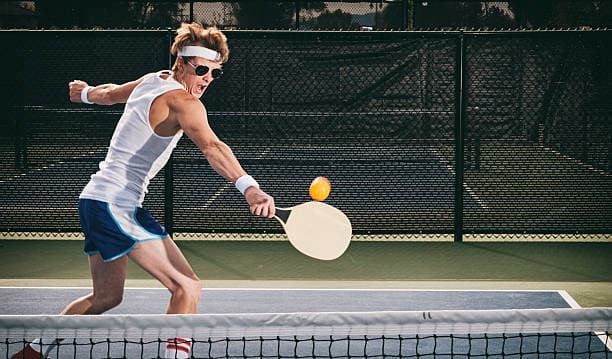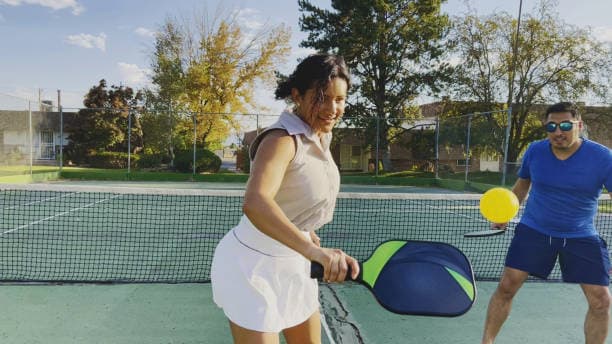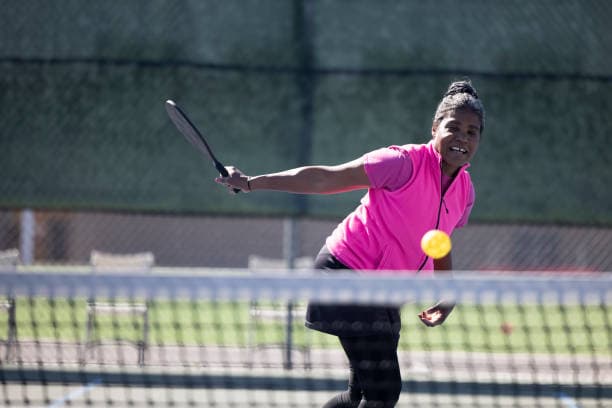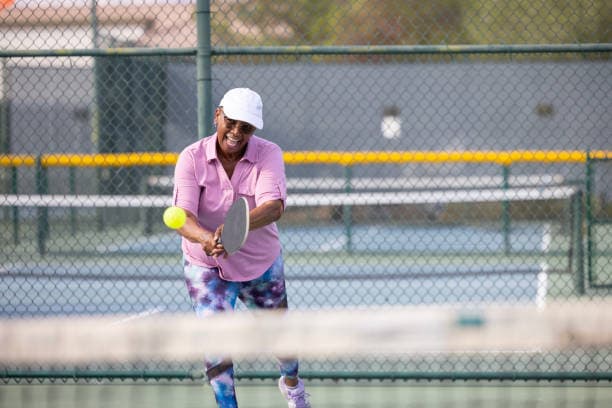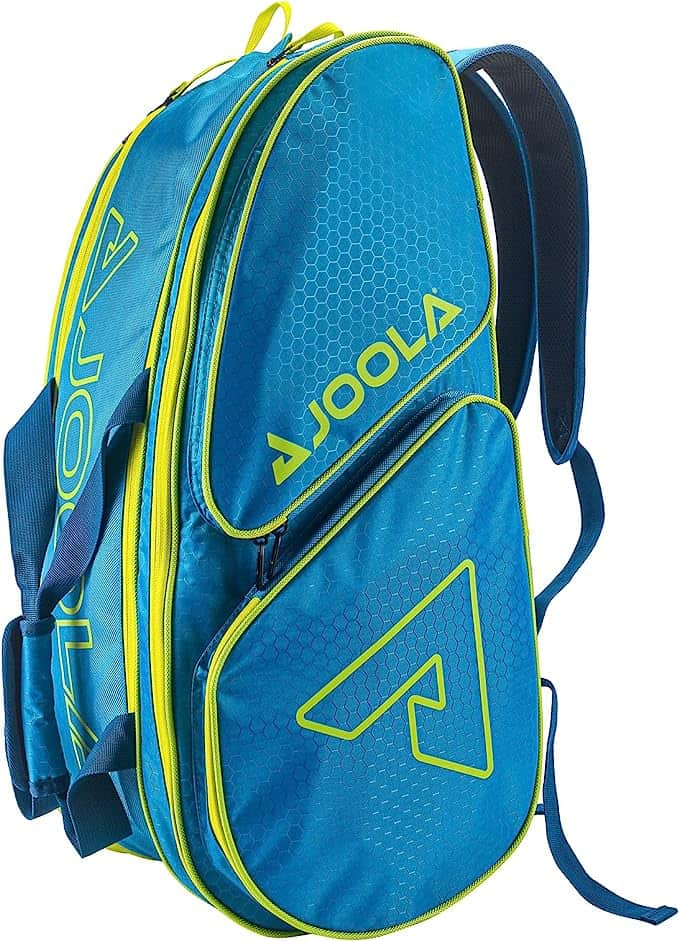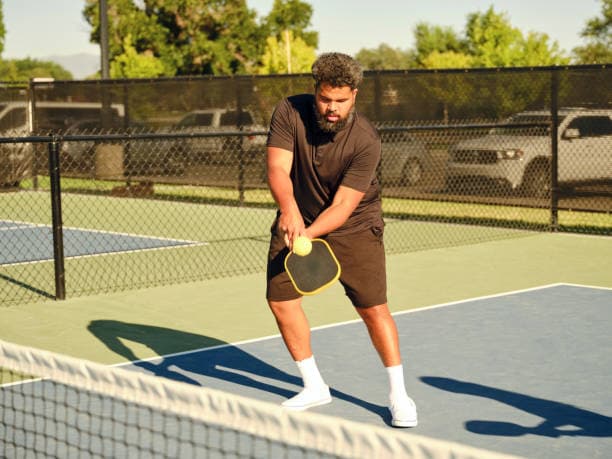Pickleball has been gaining immense popularity in recent years. While the forehand shot often takes the spotlight in pickleball discussions, the backhand shot is equally crucial in determining a player’s success on the court.
Importance of the Backhand Shot in Pickleball
In pickleball mastering both forehand and backhand shots is essential for becoming a well-rounded player. While many beginners tend to focus primarily on developing their forehand skills due to its perceived simplicity and power potential (it’s easier), neglecting the backhand can severely limit a player’s ability to execute a wide range of shots effectively. The backhand shot involves striking the ball with the non-dominant hand (for most players, this is the left hand for right-handed individuals) on the opposite side of their body.
The backhand shot in pickleball serves multiple purposes. It allows players to maintain their positioning while returning shots that come towards their non-dominant side and ensure they can cover more court and keep up with fast-paced rallies.
A well-executed backhand shot can provide strategic advantages by allowing players to redirect the ball with precision or generate power when necessary. Therefore, understanding and honing your backhand skills are crucial for achieving consistency and versatility in your pickleball game.
Distinction Between One-Handed and Two-Handed Backhands
When it comes to executing a backhand shot in pickleball, players have two distinct options: using either a one-handed or two-handed grip. The choice between these techniques depends on various factors such as personal preference, physical capabilities, playing style, and familiarity with other racquet sports.
A one-handed backhand involves gripping the paddle with one hand throughout the swing motion. This technique requires players to rely on arm extension and rotation for generating power and control during shots.
On the other hand, a two-handed backhand involves gripping the paddle handle with both hands close together. This grip provides additional support and stability during shot execution while enabling better control over high-speed shots.
One-Handed Pickleball Backhand
One-Handed Pickleball Backhand Technique and Grip
The one-handed pickleball backhand is an exquisite technique that requires finesse and precision. Think Federer. Central to this stroke is the grip, as it affects the player’s ability to control and generate power during shots.
There are three primary grip options for executing a one-handed backhand: Eastern, Continental, and Semi-Western.
The Eastern grip involves placing the base knuckle of the index finger on the third bevel of the paddle handle. This grip provides a good balance between power and control, making it suitable for players who prefer versatility in their shots.
The Continental grip entails placing the base knuckle of both index and middle fingers on top of each other at an angle on bevel two. This grip facilitates greater control over slices and drop shots due to its neutral positioning.
Last but not least, there is the Semi–Western grip which lies between Eastern and Western grips. It allows for a slightly more topspin-oriented shot while maintaining reasonable power potential. Players must experiment with all three options to determine which best suits their style of play.
Stance: Open or Closed
Once players have established their preferred grip, they must consider their stance when preparing for a one-handed backhand shot in pickleball. The stance chosen greatly influences both balance and reach during gameplay.
An open stance involves positioning your body perpendicular to the net with your front foot pointing towards it while your back foot remains parallel to it. This stance allows for quick lateral movements from side-to-side while maintaining excellent stability during shots. It also enables better reach towards wide balls on either side of the court.
On the other hand, a closed stance sees the player’s front foot angled towards the net and the back foot steps in a bit closer to it. This stance offers superior hip and shoulder rotation, allowing for more power generation during shots. While it may limit lateral movements slightly, it provides exceptional stability for powerful drives and smashes.
Swing Motion
The swing motion is a critical aspect of executing an effective one-handed pickleball backhand. Players must focus on maintaining a smooth, controlled swing while ensuring proper weight transfer throughout the stroke. The swing should start with an early preparation by turning the shoulders sideways while keeping the paddle high and close to the body.
As the ball approaches players must shift their weight from their back foot to their front foot to generate power and maintain balance during contact with the ball. During contact players should aim for a clean strike on the center of the paddle face to achieve accuracy and sweet spot paddle contact.
After making contact players must continue their follow-through by extending their arm fully towards their target. This motion ensures optimal control over slice shots and drop shots while enhancing consistency in shot placement.
Advantages of One-Handed Backhand
The one-handed pickleball backhand offers several advantages that make it an appealing choice for many players. One significant advantage is its greater reach and flexibility due to an extended arm span. The ability to fully extend one arm allows players with this technique to cover more court area during defensive plays or challenging shots from opponents.
This technique offers enhanced power potential for aggressive shots like drives and smashes. By utilizing proper weight transfer and generating substantial racquet head speed through a single arm swing, players can unleash powerful winners that put pressure on opponents.
The one-handed backhand also provides better control over slice shots and drop shots. With a single hand on the paddle, players have more finesse and touch when delicately controlling the ball’s spin and placement, making it an excellent choice for players seeking a versatile shot repertoire.
Two-Handed Pickleball Backhand
Overview of the Technique
The two-handed pickleball backhand is a popular alternative to the one-handed backhand, offering players enhanced stability and control. This technique involves a double-handed grip, with both hands close together on the paddle handle. The grip itself provides a solid foundation, allowing players to maintain greater control over their shots.
In terms of stance, a neutral or slightly open stance is recommended for optimal stability and balance. The combination of this grip and stance sets the stage for a well-executed swing motion.
Grip: Double-handed Grip
The double-handed grip used in the two-handed pickleball backhand is pivotal to its success. By holding the paddle handle with both hands positioned closely together, players benefit from increased stability and consistency in their shots. This grip allows for better leverage during powerful strokes while minimizing any potential hand slippage that may occur with a single-handed backhand. You can think of the grip as a lefty (or non dominant hand) forehand while using your dominant hand to support the paddle.
Stance: Neutral or Slightly Open
Maintaining an appropriate stance is crucial in executing an effective two-handed pickleball backhand. Opting for either a neutral or slightly open stance ensures that players have a strong base, allowing them to transfer weight smoothly during their swing motion while maintaining balance throughout. This position also facilitates quick adjustments required when reacting to fast-paced shots, providing players with additional versatility on court.
Swing Motion
The swing motion utilized in the two-handed pickleball backhand requires coordinated movement between both arms to generate maximum power behind each shot. As players initiate their stroke they utilize their dominant arm as the primary driver of force while utilizing the non-dominant arm as support and stabilization throughout the swing. This synchronized motion allows for a more controlled and powerful shot delivery especially when executed with proper technique.
Advantages of the Two-Handed Backhand
The two-handed pickleball backhand offers several advantages that contribute to its popularity among players. Firstly, the additional hand support on the paddle provides improved stability that results in a more solid and consistent shot execution. This added stability becomes particularly valuable during intense rallies or when facing challenging shots from opponents.
Secondly, the two-handed grip and coordinated swing motion enables enhanced control over high-speed and powerful shots. By utilizing both hands, players can better absorb the impact and redirect the ball with accuracy.
This advantage extends to defensive plays as well, allowing players to effectively respond to powerful shots by returning them with precision and control. Executing topspin shots becomes easier with a two-handed backhand due to increased racket head speed.
The combination of both arms working together enhances racquet acceleration through contact with the ball, resulting in a higher spin rate and improved trajectory control. This advantageous spin enables players to add depth to their shots and create strategic opportunities during gameplay.
Incorporating a two-handed pickleball backhand into one’s arsenal not only provides enhanced stability but also improves control over high-speed shots while enabling easier execution of topspin techniques. Players who master this technique will find themselves well-equipped to handle various game situations efficiently.
Comparison Between One-Handed and Two-Handed Backhands
Strengths of One-Hander Compared to Two-Hander
The one-handed backhand in pickleball offers several advantages over its two-handed counterpart. One significant strength lies in the greater reach it provides. With a longer arm span, players executing a one-handed backhand can cover a larger area of the court that allows them to retrieve and return shots that would otherwise be out of reach for players using a two-handed backhand.
This extended reach can prove particularly valuable during defensive situations when players need to stretch for wide shots or quickly recover from being pulled off balance. Furthermore, the one-handed backhand excels in generating power for aggressive shots such as drives and smashes.
The ability to fully extend the arm during the swing motion enables players to transfer more energy from their body into the shot, resulting in increased racket head speed and greater ball velocity. This added power can be advantageous both offensively, allowing players to hit winners more effectively, and defensively by providing them with the ability to hit strong defensive shots deep into their opponent’s court. Don’t forget, hitting a solid one hander doesn’t get any prettier! Think Federer, again.
Greater Reach Allows Players to Cover More Court
One of the primary strengths of the one-handed backhand is its inherent advantage in terms of reach. With an extended arm span, pickleball players utilizing a one-handed technique are able to cover more court compared to those employing a two-handed grip on their paddle.
This increased coverage allows for better court positioning as well as improved defensive capabilities. By having a longer reach with their dominant hand on the paddle, players executing a one-handed backhand can stretch further towards sideline shots that would otherwise be unattainable with a two-handed grip.
This not only enables them to return difficult shots but also helps maintain offensive pressure by keeping rallies alive through well-placed shots that opponents might expect to be out of reach. In essence, the one-handed backhand equips players with an extended arm that acts as a defensive shield, providing them with a substantial advantage in terms of court coverage and shot retrieval.
My Opinion
I have a tennis background so I personally use a two handed backhand because this is what I am most comfortable with. Being comfortable and confident is important. I suggest learning both, the one hander and two hander and figure out which is more comfortable. I also suggest for those using two handed backhands to learn the one handed backhand slice to add some variety to your game. It’s important to be able to mix and match different shots into rallies to keep your opponents on their toes as well as to give yourself as many options as possible.
Conclusion
In the realm of pickleball, the choice between the one-handed and two-handed backhand is ultimately a matter of personal preference and playing style. While both techniques have their unique merits, it’s clear that the one-handed backhand offers distinct advantages in terms of reach and court coverage.
So, whether you prefer the finesse and flexibility conferred by a one-handed backhand or opt for the stability and control associated with a two-handed grip, honing these skills will undoubtedly help you navigate your way through intense matches with confidence and finesse. Embrace your preferred technique, practice diligently, and watch as your pickleball prowess blossoms on the court.

